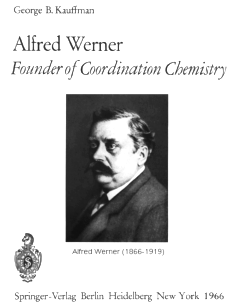Werner Complexes
The history of modern coordination chemistry has been the subject
of several books, of which perhaps the best known are those by
George B. Kauffman. By necessity they all highlight Alfred
Werner, "the Father of Coordination Chemistry" who in 1893,
proposed the octahedral configuration of transition metal
complexes and in 1913 received the first Nobel
prize in Inorganic Chemistry.

In this series of experiments, some simple cobalt(III) complexes
are to be prepared, which show some of the properties that Werner
was able to interpret using the octahedral model. These include;
optical, geometric and linkage isomerism.
The oxidation of cobalt sulfate to the tetraamminecarbonate
complex can be done by passing air through the solution for 2
hours, or more conveniently using hydrogen peroxide (although
this is more costly, it allows the experiment to be easily
completed in one session). The conversion of the bis-aqua complex
to "hexol" given here is the method originally used by Jorgensen.
By contrast, Werner added pyridine to a hot, dilute acetic acid
solution. "Hexol" exists in several hydrated forms, all of them
dark purple-black crystals. Air-drying the crystals has been
found to result in the ennea-hydrate, whereas drying at 98C or
over sulfuric acid results in the tetrahydrate.
The nitrite ion (NO2-) is an example of an ambidentate ligand. That is,
it can form a bond to a metal via either of two non-equivalent
sites, from the N or from an O.
In the second scheme, two linkage isomers of the type
[CoONO(NH3)5]2+ and
[CoNO2(NH3)5]2+ are
prepared starting from
[CoCl(NH3)5]2+.
The actual isomer obtained depends on the pH of the solution. it
should be noted that the two isomers are in equilibrium and that
the nitro compound is the more stable. Whereas isomerisation
takes several months at room temperature it is greatly
accelerated by heating. Therefore the products should NOT be
heated.
Kinetic Study
The nitrito isomer converts slowly at room temperature to the
nitro isomer and the conversion can be conveniently followed by
observing the disappearance of the nitrito band at approximately
1060 cm-1 in the IR spectrum.
Collect an IR spectrum of the penataamminechlorocobalt(III)
chloride for comparison.
The kinetic study should be started as soon as the KBr pellet of
the nitrito isomer has been prepared. The IR spectrum of this
pellet is run between 1200 and 900 cm-1 at various
time intervals over a period of three weeks, ensuring that at
least 6 recordings are made (e.g. 0, 0.125, 0.5, 2.0, 4.0, 11.0,
18.0 days).
The pellet should be kept in a dessicator in the dark at room
temperature between readings.
It is assumed that for the KBr pellet the path length is
constant; therefore the concentration of the complex is
proportional to the Absorbance or log (T0/T). The T
value is read directly from the % transmittance recording paper
and T0 is estimated by connecting the baseline
immediately to the left and right of the nitrito band and
averaging the readings.
At the end of the experiment, the KBr pellet is placed in an
oven at 100°C to complete the isomerisation and to obtain an
A(infinity) measurement.
Plot a graph of log (A-Ainf) versus time. The rate
constant k for isomerisation is equal to 2.303*slope and the
reaction is found to obey first-order kinetics.
References
"Classics in Coordination Chemistry - Part 1", G.B. Kauffman,
Dover Publications Inc., N.Y., 1968.
"Alfred Werner - Founder of Coordination Chemistry", G.B.
Kauffman, Springer-Verlag, Berlin, Heidelberg, New York, 1966.
"Inorganic Coordination Compounds", G.B. Kauffman, Heyden &
Son, Ltd., London, Philadelphia, Rheine, 1981.
Cobalt(III) Ammines - "Werner" Complexes, A.M. Greenaway and
R.J. Lancashire, J. Chem. Educ., 1982, 59, 419-420.
Coordination Complexes of Cobalt, G.M. Williams, J. Olmsted III
and A.P. Breksa III, J. Chem. Educ., 1989, 66, 1043-1045.
The Resolution of a Completely Inorganic Coordination Compound,
T. Yasui, T. Ama and G.B. Kauffman, J. Chem. Educ., 1989, 66,
1045-1048.
 Return to Chemistry, UWI-Mona,
Home Page
Return to Chemistry, UWI-Mona,
Home Page
Copyright © 2006 by Robert John
Lancashire, all rights reserved.
Created and maintained by Prof. Robert J. Lancashire,
The Department of Chemistry, University of the West Indies,
Mona Campus, Kingston 7, Jamaica.
Created Feb 1995. Links checked and/or last
modified 5th September 2006.
URL
http://wwwchem.uwimona.edu.jm/lab_manuals/Werner.html


 Return to Chemistry, UWI-Mona,
Home Page
Return to Chemistry, UWI-Mona,
Home Page